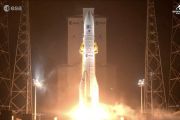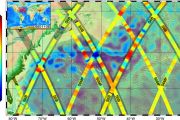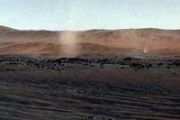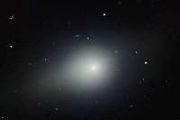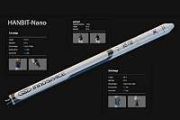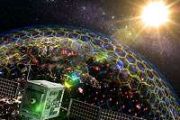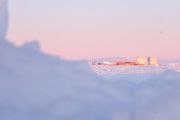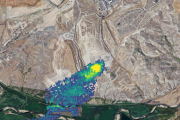
Copernical Team
NASA simulator helps to shed light on mysteries of Solar System
 Even in our cosmic backyard, the Solar System, many questions remain open. On Venus there are formations similar to volcanoes, but it is not known if they are active. The surface of Mars suggests that there was once a vast ocean, but how it disappeared remains unclear. On the other hand, recent detections of chemical compounds that may indicate the presence of biological activity on Mars and Ven
Even in our cosmic backyard, the Solar System, many questions remain open. On Venus there are formations similar to volcanoes, but it is not known if they are active. The surface of Mars suggests that there was once a vast ocean, but how it disappeared remains unclear. On the other hand, recent detections of chemical compounds that may indicate the presence of biological activity on Mars and Ven Making Tracks to the Delta
 Perseverance is in a drive campaign going faster than any previous rover. How fast, you may ask? Its actual speed is just under a tenth of a mile per hour, but it's faster than its predecessors. It is making comparatively rapid progress by devoting several hours per day to driving on very smooth terrain.
That has allowed Perseverance to break previous rovers' records for the distance trave
Perseverance is in a drive campaign going faster than any previous rover. How fast, you may ask? Its actual speed is just under a tenth of a mile per hour, but it's faster than its predecessors. It is making comparatively rapid progress by devoting several hours per day to driving on very smooth terrain.
That has allowed Perseverance to break previous rovers' records for the distance trave NASA's Perseverance rover listens in the thin Martian atmosphere
 Mars has a very thin atmosphere, which at the surface has a density approximately one percent that of Earth's. Until recently, it was unclear whether there is anything to hear in the barren landscape there and if it is even possible for sound to be recorded under these conditions. When NASA's Perseverance Mars rover landed on the Red Planet on 18 February 2021, it was carrying two microphones.
Mars has a very thin atmosphere, which at the surface has a density approximately one percent that of Earth's. Until recently, it was unclear whether there is anything to hear in the barren landscape there and if it is even possible for sound to be recorded under these conditions. When NASA's Perseverance Mars rover landed on the Red Planet on 18 February 2021, it was carrying two microphones. Magma makes marsquakes rock Red Planet
 Volcanic activity beneath the surface of Mars could be responsible for triggering repetitive marsquakes, which are similar to earthquakes, in a specific region of the Red Planet, researchers from The Australian National University (ANU) suggest.
New research published in Nature Communications shows scientists from ANU and the Chinese Academy of Sciences in Beijing have discovered 47 previo
Volcanic activity beneath the surface of Mars could be responsible for triggering repetitive marsquakes, which are similar to earthquakes, in a specific region of the Red Planet, researchers from The Australian National University (ANU) suggest.
New research published in Nature Communications shows scientists from ANU and the Chinese Academy of Sciences in Beijing have discovered 47 previo Roscosmos to Brief Russian Government on Options for Ending ISS Cooperation Soon, Rogozin Says
 The Russian space agency Roscosmos will soon inform the government of how it plans to terminate cooperation with Western partners on the International Space Station, its chief said.
"Roscosmos will present its concrete proposals on the timeline for ending ISS cooperation with US, Canadian, EU and Japanese space agencies to the leadership of our country soon," Dmitry Rogozin said on Telegra
The Russian space agency Roscosmos will soon inform the government of how it plans to terminate cooperation with Western partners on the International Space Station, its chief said.
"Roscosmos will present its concrete proposals on the timeline for ending ISS cooperation with US, Canadian, EU and Japanese space agencies to the leadership of our country soon," Dmitry Rogozin said on Telegra Aphelion Aerospace secures investment from The Mercury Group and others
 Aphelion Aerospace, based in Denver, Colorado is establishing itself as a one-stop-shop for low-cost small satellite integration and on-demand launch operations from practically anywhere around the world. Aphelion reports it has received significant investment from strategic investors including The Mercury Group, Founder Advisors, and Richtr Financial Studio. These investments are part of Apheli
Aphelion Aerospace, based in Denver, Colorado is establishing itself as a one-stop-shop for low-cost small satellite integration and on-demand launch operations from practically anywhere around the world. Aphelion reports it has received significant investment from strategic investors including The Mercury Group, Founder Advisors, and Richtr Financial Studio. These investments are part of Apheli Omnispace and Thales Alenia Space report launch of first satellite mission
 Omnispace and Thales Alenia Space, a joint venture between Thales (67%) and Leonardo (33%), are proud to announce that Omnispace Spark-1 was successfully delivered into orbit aboard the SpaceX Transporter-4. The Omnispace Spark program represents phase one in the development and delivery of the world's first standards-based global hybrid network.
Thales Alenia Space designed and built the
Omnispace and Thales Alenia Space, a joint venture between Thales (67%) and Leonardo (33%), are proud to announce that Omnispace Spark-1 was successfully delivered into orbit aboard the SpaceX Transporter-4. The Omnispace Spark program represents phase one in the development and delivery of the world's first standards-based global hybrid network.
Thales Alenia Space designed and built the Blue Canyon Technologies to supply spacecraft buses for HelioSwarm Mission
 Small satellite manufacturer and mission services provider Blue Canyon Technologies LLC or "BCT" or "Blue Canyon", a wholly-owned subsidiary of Raytheon Technologies, was selected to build eight X-SAT Venus ESPA-class microsatellite buses for NASA's HelioSwarm science mission. The purpose of the mission will be to study the solar wind and space plasma turbulence.
The HelioSwarm mission is
Small satellite manufacturer and mission services provider Blue Canyon Technologies LLC or "BCT" or "Blue Canyon", a wholly-owned subsidiary of Raytheon Technologies, was selected to build eight X-SAT Venus ESPA-class microsatellite buses for NASA's HelioSwarm science mission. The purpose of the mission will be to study the solar wind and space plasma turbulence.
The HelioSwarm mission is D-Orbit Launches its Fifth ION Satellite Carrier Mission
 D-Orbit, the space logistics and orbital transportation company, has launched Spacelust, the fifth mission of the Company's proprietary ION Satellite Carrier (ION), aboard SpaceX's Transporter-4 mission. The Falcon 9 rocket lifted off April 1, 2022, at 12:24 PM EDT from the Space Launch Complex 40 (SLC-40) at Cape Canaveral Space Force Station (CCSFS), Florida. ION, a versatile and cost-effectiv
D-Orbit, the space logistics and orbital transportation company, has launched Spacelust, the fifth mission of the Company's proprietary ION Satellite Carrier (ION), aboard SpaceX's Transporter-4 mission. The Falcon 9 rocket lifted off April 1, 2022, at 12:24 PM EDT from the Space Launch Complex 40 (SLC-40) at Cape Canaveral Space Force Station (CCSFS), Florida. ION, a versatile and cost-effectiv HawkEye 360 launches next-generation Cluster 4 satellites
 HawkEye 360 Inc., the world's leading commercial provider of space-based radio frequency (RF) data and analytics, reports that its Cluster 4 satellites have successfully launched aboard a SpaceX Falcon 9 rocket from the Cape Canaveral site on April 1. The trio of HawkEye 360 satellites, each containing an RF payload developed by HawkEye 360, has established communication with ground control and
HawkEye 360 Inc., the world's leading commercial provider of space-based radio frequency (RF) data and analytics, reports that its Cluster 4 satellites have successfully launched aboard a SpaceX Falcon 9 rocket from the Cape Canaveral site on April 1. The trio of HawkEye 360 satellites, each containing an RF payload developed by HawkEye 360, has established communication with ground control and 
